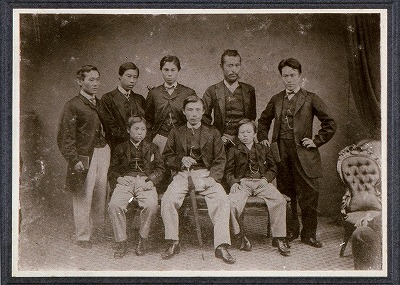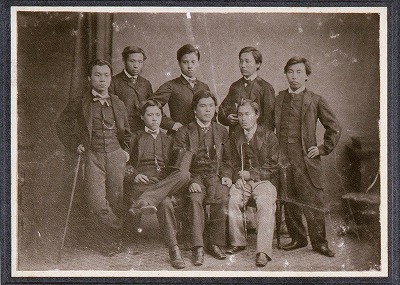2015 marks the 150th anniversary of the arrival in the United Kingdom of the Satsuma Students from Kagoshima. There are a number of events being held throughout the year to commemorate the anniversary. The logo above was designed by a 7-year old pupil from Hashima Primary School in Kagoshima for the group called SATSUMA 150, consisting of people based in the UK with links to Kagoshima. The logo is a combination of the Satsuma domain symbol and the Union Flag of the United Kingdom.
|
Present-day Kagoshima, at the very south-western tip of Japan's four main islands, was formerly known as the province of Satsuma. Farthest away from the Shogun in Edo (present-day Tokyo) the daimyo, or lords of Satsuma, exercised relative autonomy and with the province being almost surrounded by water, Satsuma controlled trade with the Ryukyu Islands (present-day Okinawa). There was frequent overseas contact in this part of Japan even though maritime trade was generally forbidden by the Shogunate and very limited in Japan at that time. As a result, throughout the Edo period (1603 – 1868) Satsuma was one of the wealthiest, most powerful and most ambitious provinces in Japan.
Nowadays, on arrival at the central station in Kagoshima on the relatively recently constructed Kyushu high-speed train line, one is confronted with a tall monument comprising a number of bronze statues of young men gazing out on all sides in triumph. This monument is the ‘Spirit of Young Satsuma’ and these are the Satsuma Students of whom Kagoshima is rightly very proud. They were young pioneers in the new Japan that emerged in the 19th century who lived and studied in the United Kingdom.
|
 Spirit of Satsuma (c) Tomoyo Noma
Spirit of Satsuma (c) Tomoyo Noma
|
In 1865, some three years before the Meiji Restoration in 1868, and when travelling overseas was still forbidden by the Shogunate, nineteen young men set sail on a secret mission from the tiny village of Hashima on the west coast of the Satsuma peninsula.
These nineteen young men and boys had been chosen to embark on ‘a voyage of investigation to the technologically advanced island of Britain’, a scheme initiated originally by the broad-minded and outward-looking lord of Satsuma, Shimazu Nariakira (1809 – 1858). Due to the sudden death of the daimyo and the political turmoil that engulfed Japan at this time, the original 1857 plan was never realised.
In 1863, Kagoshima was bombarded by the British Royal Navy in retaliation for what became known as the ‘Namamugi Incident, ’ in which a British merchant, Charles Lennox Richardson, was killed by a Satsuma retainer while out riding near the village of Namamugi near Yokohama. A fleet of Royal Navy vessels arrived in Kagoshima and made it clear to the rulers of Satsuma that if the Japanese would like to take part on the world stage, they would have to learn from technologically advanced Europe. As a result, Satsuma acted independently from the Shogunate and put into practice the abandoned plan of 1857 to send Satsuma students abroad.
The majority of the group of nineteen ‘Satsuma Students’ were students and teachers from Kaiseijo, Satsuma’s brand new college of Western Studies (established in 1864) which was attended by the most brilliant young men of Satsuma’s samurai elite.
On the morning of 17 April 1865, the Australain, a small steamship provided by Thomas Glover, a Scottish merchant in Nagasaki, set sail from Hashima for Hong Kong on the start of the Satsuma Students’ journey to the United Kingdom. They arrived in Southampton on 21 June later that year. They were bound for study in London at University College. The students lodged with a number of university lecturers throughout the city though they were not to stay together for long. A few set out on their travels around the United Kingdom and to continental Europe and the United States and one after another, they mostly returned to Japan. The Satsuma Students lived overseas in the United Kingdom, some for just a year, others for as long as ten. As a result of their studies, they became a part of the story of the creation of a new Japan and a significant part of Kagoshima’s rich cultural history along with national heroes from Kagoshima such as Saigo Takamori and Okubo Toshimichi.
|
Yet in fact, only seventeen were from Satsuma, one was from Tosa (present-day Kochi) and another was from Nagasaki. Only seventeen statues appear on the monument outside Kagoshima’s main station and perhaps one day the remaining two will take their place alongside the others. All nineteen are, however, are remembered on the Japan Monument ( https://www.ucl.ac.uk/museums/about/japanese-pioneers/monument) in University College London together with the names of the five students from Choshu, the so-called Choshu Five, who also studied there. The inscription on the side of the monument reads,
はるばるとこころつどいてはなさかる
(Harubaru to kokoro tsudoite hana sakaru)
‘When distant minds come together, cherries blossom’
|
Some of the achievements by Satsuma Students are as below:
Terashima Munenori became an influential Meiji-era diplomat who was posted in London in 1872 with full plenipotentiary powers and then returned to Japan to become Gaimukyo, equivalent to today’s Foreign Minister.
Mori Arinori is well-known for modernising the education system of Japan and became the first Minister of Education in 1885. He established Hitotsubashi University in 1875.
Godai Tomoatsu was an entrepreneur and a founder of the Osaka Chamber of Commerce and Industry. He became a leading light in the industrial development of Osaka, the ‘Manchester of the Orient’.
Machida Hisanari became the first director of museums within the Ministry of Home Affairs and the first director of what is now the Tokyo National Museum.
Nagasawa Kanae, the youngest of the original group who went to study in Scotland, became a pioneering settler in California developing wine production in the state and became known as the ‘Grape King’.
Sixteen members of the Satsuma Students in London on 2 August 1865: (Kagoshima Prefectural Library)
|
 Back row (left - right): Asakura Moriaki, Machida Shinshiro, Sameshima Naonobu, Terashima Munenori, Yoshida Kiyonari.
Back row (left - right): Asakura Moriaki, Machida Shinshiro, Sameshima Naonobu, Terashima Munenori, Yoshida Kiyonari.
Front row (left - right): Machida Seizo, Machida Hisanari, Nagasawa Kanae |
 Back row (left - right): Hatakeyama Yoshinari, Takami Yaichi, Murahashi Hisanari, Togo Ainoshin, Nagoya Tokinari.
Back row (left - right): Hatakeyama Yoshinari, Takami Yaichi, Murahashi Hisanari, Togo Ainoshin, Nagoya Tokinari.
Front row (left - right): Mori Arinori, Matsumura Junzo, Nakamura Hakuai
|
|
|

